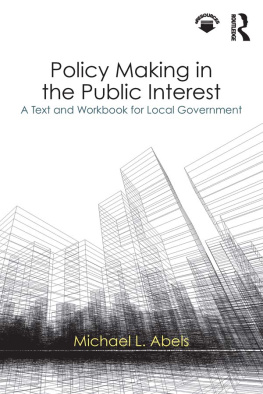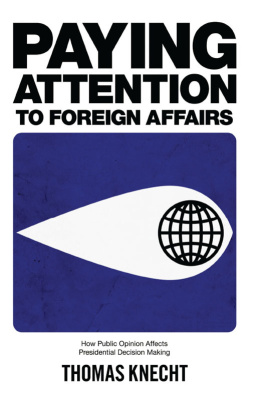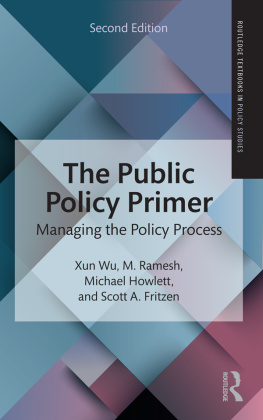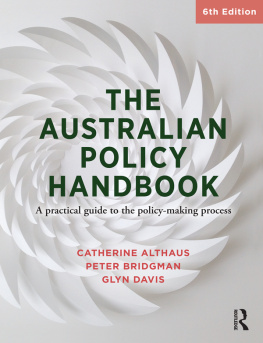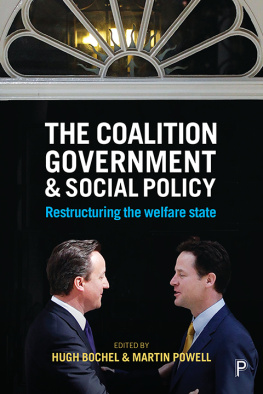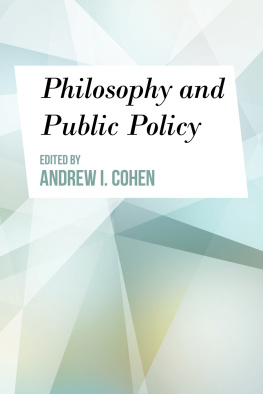MAKING AND IMPLEMENTING PUBLIC POLICY
MAKING AND IMPLEMENTING PUBLIC POLICY
KEY CONCEPTS AND ISSUES
CATHERINE BOCHEL AND HUGH BOCHEL
Catherine Bochel and Hugh Bochel 2018
All rights reserved. No reproduction, copy or transmission of this publication may be made without written permission.
No portion of this publication may be reproduced, copied or transmitted save with written permission or in accordance with the provisions of the Copyright, Designs and Patents Act 1988, or under the terms of any licence permitting limited copying issued by the Copyright Licensing Agency, Saffron House, 610 Kirby Street, London EC1N 8TS.
Any person who does any unauthorized act in relation to this publication may be liable to criminal prosecution and civil claims for damages.
The authors have asserted their rights to be identified as the authors of this work in accordance with the Copyright, Designs and Patents Act 1988.
First published 2018 by
PALGRAVE
Palgrave in the UK is an imprint of Macmillan Publishers Limited, registered in England, company number 785998, of 4 Crinan Street, London, N1 9XW.
Palgrave and Macmillan are registered trademarks in the United States, the United Kingdom, Europe and other countries.
ISBN 9781137484642 paperback
This book is printed on paper suitable for recycling and made from fully managed and sustained forest sources. Logging, pulping and manufacturing processes are expected to conform to the environmental regulations of the country of origin.
A catalogue record for this book is available from the British Library.
A catalog record for this book is available from the Library of Congress.
LIST OF TABLES, FIGURES & BOXES
Tables
Figures
Boxes
PREFACE
This book reflects our longstanding teaching and research interests, and perhaps, in particular, a concern with how inequalities in and the exercise of power in policy making and implementation lead to particular policies and outcomes, while others are excluded. It also reflects the very significant developments in studies of public policy over the past two decades, in both empirical and theoretical work, as well as the impact of policy approaches of a variety of governments. We have sought here to describe and apply ideas associated with some of the main contemporary debates over the making and implementation of public policy in order to help explain and understand the policy process using different conceptual frameworks. In particular, we would hope that readers will consider how and to what extent the exercise of power both reflects and contributes to other inequalities in contemporary society.
Although this work is our responsibility, we are grateful to four anonymous reviewers for their comments and suggestions, which helped improve both the contents and the quality of the book. We would also like to recognise the many students who, over the years, have contributed to our thoughts on these topics, and whose work has, at times, helped inform our ideas.
Finally, we are grateful to the editors at Palgrave Macmillan, Helen Caunce, who was involved in the initial development of the book, and subsequently Peter Hooper, as well as Rita Ondarra Capdevila, who also provided significant assistance in the run-up to the books delivery.
Catherine Bochel and Hugh Bochel
University of Lincoln
ACKNOWLEDGEMENTS
The authors and publishers wish to thank the following for permission to reproduce copyright material:
Coleman, A., Segar, J. and Checkland, K. (2016) The Devolution Project in Greater Manchester: Introduction to the Special Issue, Representation, 51(4), 377384, p. 380, reproduced with the permission of Taylor & Francis, on behalf of the McDougall Trust, London;
Crown copyright information is reproduced with the permission of the Controller of HMSO and the Queens Printer for Scotland;
Freeguard, G., Andrews, E., Devine, D., Munro, R. and Randall, J. (2015) Whitehall Monitor 2015: The Coalition in 163 charts, London: Institute for Government, p. 11, reproduced with permission of the Institute for Government;
Gash, T., Magee, I., Rutter, J. and Smith, N. (2010) Read Before Burning: Arms Length Government for a New Administration, London: Institute for Government, p. 22, reproduced with permission of the Institute for Government;
Greener, I. (2013) Public Management, Basingstoke: Palgrave Macmillan, p. 69, reproduced with permission of Palgrave Macmillan;
Wilson, D. and Game, C. (2011) Local Government in the United Kingdom, Basingstoke: Palgrave Macmillan, p. 338, reproduced with permission of Palgrave Macmillan;
the book contains parliamentary information licensed under the Open Parliament Licence v3.0;
the book contains public sector information licensed under the Open Government Licence v3.0.
Every effort has been made to trace the copyright holders, but if any have been inadvertently overlooked the publishers will be pleased to make the necessary arrangement at the first opportunity.
Public Policy and Policy Analysis
This chapter discusses the meanings and scope of public policy and the ways in which the term is used in this book. It considers the development of interest in policy analysis and the uses to which it can be put. The chapter outlines the importance of power and the ways in which it can be exercised. It then considers different approaches to analysing the policy process, including those that consider stages and those grounded in more dynamic perspectives.
The chapter concludes with a brief consideration of important themes and developments under governments since 1979, including the ongoing influence of neo-liberal thinking, changes such as the introduction of the devolved legislatures, and the referendum decision in 2016 to leave the EU, with significant implications for the policy process across all tiers of government.
The study of the making and implementation of public policy is interdisciplinary in nature, drawing upon subjects such as politics, sociology, economics and history, and indeed many others. It is also dynamic and constantly changing, both with respect to the world that we seek to understand, and the concepts, models and methods that we have available to assist us.
While the subject matter covered by this book is wide-ranging, including both theoretical perspectives on and real-world examples of public policy, at its heart might be said to lie a consideration of the exercise of power, and, in particular, who has it (and who does not) and how it is used and applied in the public policy arena. Public policy making is obviously, at least to some extent, about responding to problems. But, equally obviously, public policy responds to problems in many ways, with different aims and different outcomes. The book therefore examines the processes by which public policies are formulated, implemented and evaluated. This includes outlining and applying models of agenda setting and decision making, the variety of actors in the policy process, including politicians, bureaucrats and managers, and considering the operation of different levels of government, including supra-national, central and local government, the tools that they use, and how policies are evaluated and those assessments fed back into policy making. The focus is not simply on who makes decisions, but on a broader concern with the entire policy process. In addition, the book seeks to go slightly beyond the common focus of much of the literature, the how element of Lasswells (1936/1858) who gets what, when, how, to argue that the how significantly influences the who, what and when, and to explore this in the context of public policy in the United Kingdom in particular, while recognising that both ideas and policies are subject to international, and indeed global, influence.




